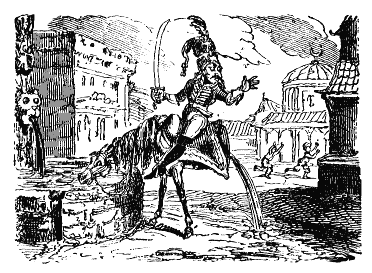1720年5月11日は、「ほら吹き男爵」のミュンヒハウゼン男爵の生まれた日♪
奇想天外な物語「ほら吹き男爵の冒険」は、実在の18世紀のドイツ貴族ミュンヒハウゼン男爵が周囲に語った冒険談が元となっている♪
ミュンヒハウゼン男爵カール・フリードリヒ・ヒエロニュムスは、第5子として生まれる。アントン・ウルリヒ公爵の小姓としてロシアに渡り、1739年にロシア軍騎兵に志願、大尉に昇進するが、兄が戦死したので家名を継ぐためにドイツに帰国した。
ミュンヒハウゼン男爵は、晩年、客を集めては自分の体験談を話して聞かせたが、それがあまりにも荒唐無稽で面白いので、ある人物がこっそり記録し、無断で「ほら吹き男爵の冒険」として出版した。男爵は「ほら吹き」呼ばわりに激怒して出版をやめさせようとしたがかなわず、本は売り出されて大人気(笑 男爵は憤慨のあまり死んでしまったという。
 |
| 荷車を担いで運んだ |
 |
| 砲弾に乗って飛んだ |
 |
| 半身の馬で進軍した |
 |
| 半身の馬の銅像 |
ミュンヒハウゼン男爵がほら話で周囲の関心を集めたことから、後世、周囲の関心を引く為に病気を装ったり自傷したりする精神疾患を「ミュンヒハウゼン症候群」と呼ぶようになったという♪
Baron Munchausen is a fictional German nobleman created by the German writer Rudolf Erich Raspe in his 1785 book Baron Munchausen's Narrative of his Marvellous Travels and Campaigns in Russia. The character is loosely based on a real baron, Hieronymus Karl Friedrich, Freiherr von Münchhausen (11 May 1720, German pronunciation).
Born in Bodenwerder, Electorate of Brunswick-Luneburg, the real-life Münchhausen fought for the Russian Empire in the Russo-Turkish War. On retiring in 1760, he became a minor celebrity within German aristocratic circles for telling outrageous tall tales based on his military career. After hearing some of Münchhausen's stories, Raspe adapted them anonymously into literary form, first in German as ephemeral magazine pieces and then in English as the 1785 book, which was first published in Oxford by a bookseller named Smith. The book was soon translated into other European languages, including a German version expanded by the poet Gottfried August Bürger. The real-life Münchhausen was deeply upset at the development of a fictional character bearing his name, and threatened legal proceedings against the book's publisher. Perhaps fearing a libel suit, Raspe never acknowledged his authorship of the work, which was only established posthumously.
The fictional Baron's exploits, narrated in the first-person, focus on his impossible achievements as a sportsman, soldier, and traveller, for instance riding on a cannonball, fighting a forty-foot crocodile, and travelling to the Moon. Intentionally comedic, the stories play on the absurdity and inconsistency of Munchausen's claims, containing an undercurrent of social satire. The earliest illustrations of the character, perhaps created by Raspe himself, depict Munchausen as slim and youthful, although later illustrators have depicted him as an older man, and have added the sharply beaked nose and twirled moustache that have become part of the character's definitive visual representation. Raspe's book was a major international success, becoming the core text for numerous English, continental European, and American editions that were expanded and rewritten by other writers. The book in its various revised forms remained widely read throughout the nineteenth century, especially in editions for young readers.
Versions of the fictional Baron have appeared on stage, screen, radio, and television, as well as in other literary works. Though the Baron Munchausen stories are no longer well-known in English-speaking countries, they are still popular in continental Europe. The character has inspired numerous memorials and museums, and several medical conditions and other concepts are named after him, including Munchausen syndrome, the Münchhausen trilemma, and Munchausen numbers.



0 件のコメント:
コメントを投稿